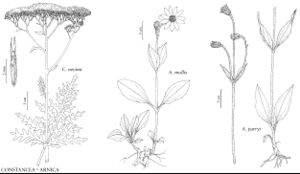Arnica mollis
Fl. Bor.-Amer. 1: 331. 1834.
Plants 15–70 cm. Stems (forming clumps) simple or branched among heads. Leaves (2–)3(–4) pairs, mostly cauline (basal sometimes present); petiolate (petioles relatively short, broad-winged) or subsessile; blades broadly elliptic, lance-elliptic, or narrowly to broadly lanceolate, 4–20 × 1–4 cm, margins entire or irregularly denticulate, apices acute, faces sparsely to moderately hairy (hairs relatively short to long, stipitate glands or soft, silky). Heads 1 or 3–7. Involucres hemispheric to campanulate. Phyllaries 10–22, usually broadly lanceolate, rarely narrowly lanceolate or oblanceolate. Ray florets 10–22; corollas yellow. Disc florets: corollas yellow; anthers yellow. Cypselae grayish brown to black, 4–8 mm, mostly stipitate-glandular, sparsely hirsutulous (hairs white to brownish, simple or bifid); pappi tawny, bristles plumose (with deep, amberlike deposits). 2n = 38, 57, 76, 95, 114, 133, 152.
Phenology: Flowering Jun–Sep.
Habitat: Moist meadows and conifer forests, stream banks, late snow-melt areas, montane to subalpine
Elevation: 1000–4000 m
Distribution

Alta., B.C., N.W.T., Yukon, Alaska, Calif., Colo., Idaho, Mont., Nev., Oreg., Utah, Wash., Wyo.
Discussion
Selected References
None.
